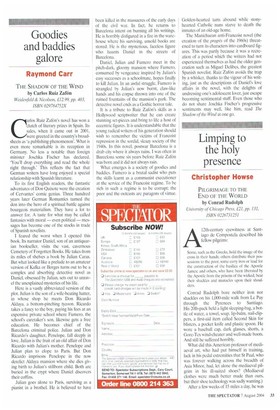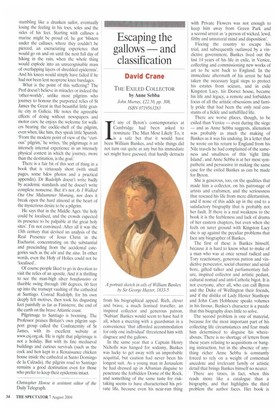Limping to the holy presence
Christopher Howse
PILGRIMAGE TO THE END OF THE WORLD by Conrad Rudolph University of Chicago Press, £21, pp. 131, ISBN 0226731251 A. 12th-century eyewitness at Santiago de Compostela described his fellow pilgrims:
Some, such as the Greeks, hold the image of the cross in their hands; others distribute their possessions to the poor; some carry iron or lead for the construction of the basilica of the Apostle James; and others, who have been liberated by the Apostle from the prisons of the wicked, bear their shackles and manacles upon their shoulders.
Conrad Rudolph bore neither iron nor shackles on his 1,000-mile walk from Le Puy through the Pyrenees to Santiago. His 20Ib-pack held a light sleeping-bag, a bottle of water, a towel, soap, lip-balm, nail-clippers, a first-aid item called Second Skin for blisters, a pocket knife and plastic spoon. He wore a baseball cap, dark glasses, shorts, a Gore-Tex wind-cheater and well-made boots. And still he suffered horribly.
What did this American professor of mediaeval art, who had put himself in training, lack in his pedal extremities that St Paul, who was forever walking across the breadth of Asia Minor, had, let alone the mediaeval pilgrim in his ill-suited shoes? (Mediaeval clothes were much better made than ours, but their shoe technology was sadly wanting.) After a few weeks of 15 miles a day, he was stumbling like a drunken sailor, eventually losing the feeling in his toes, soles and the sides of his feet. Starting with calluses a marine might be proud of, he got 'blisters under the calluses, where they couldn't be pierced, an excruciating experience that would go on and on until the next full day of hiking in the rain, when the whole thing would explode into an unrecognisable mass of overlapping layers of shredded epidermis'. And his knees would simply have failed if he had not been lent neoprene knee bandages.
What is the point of this suffering? The Prof doesn't believe in miracles or indeed the 'other-worldy', unlike most pilgrims who journey to honour the purported relics of St James the Great in that beautiful little granite city in Galicia. He notes the agreeable effects of doing without newspapers and motor cars; he enjoys the welcome for walkers bearing the cockle-shell of the pilgrim, even when, like him, they speak little Spanish. 'From the modern point of view of the "curious" pilgrim,' he writes, 'the pilgrimage is an intensely internal experience in an intensely physical context in which the journey, more than the destination, is the goal.'
There is a fair bit of this sort of thing in a book that is virtuously short (with small pages, some b&w photos and a practical appendix). Dr Rudolph doesn't write badly by academic standards and he doesn't write complete nonsense. But it's not As I Walked Out One Midsummer Morning, nor does it break open the hard almond at the heart of the mysterious desire to be a pilgrim.
He says that in the Middle Ages 'the holy could be localised, and the crowds expected its presence to be palpable at the great holy sites'. I'm not convinced. After all it was the 13th century that devised an analysis of the Real Presence of Jesus Christ in the Eucharist. concentrating on the substantial and prescinding from the accidental categories such as the ubi and the situs. In other words, even the Holy of Holies could not be 'localised'.
Of course people liked to go in devotion to visit the relics of an apostle. And it is thrilling to see the man-high silver botafumeiro or thurible swing through 180 degrees, 60 feet up into the transept vaulting of the cathedral at Santiago. Conrad Rudolph, for his own deeply felt motives, then took his disgusting feet painfully as far as Finisterre, the end of the earth on the brave Atlantic coast.
Pilgrimage to Santiago is booming. The Professor praises Britain's own pilgrim support group called the Confraternity of St James, with its excellent website at www.csj.org.uk. He is right that pilgrimage is not a holiday. But with its fine mediaeval buildings and curious survivals (such as the cock and hen kept in a Renaissance chicken house inside the cathedral at Santo Domingo de la Calzada), the pilgrim road to Santiago remains a good destination even for those who prefer to keep their epidermis intact.
Christopher Howse is assistant editor of the Daily Telegraph.



























































 Previous page
Previous page